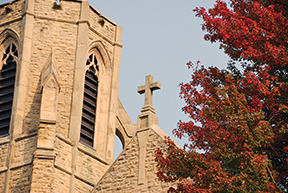
As St. Bernard of Clairvaux Church undergoes extensive construction on the corner of Atwood Ave. and Corry St. in Madison, many eagerly await its completion and elevation to the cathedral of the Diocese of Madison in late 2025.
Anticipating the end of construction, Pastor Michael Radowicz said, “When you do a renovation this big, there is always going to be closure,” and added that with closure, “Then, there’s also an opportunity for new beginnings.”
Namely, the dedication of the Cathedral of St. Bernard of Clairvaux in 2025 will open a new chapter in the life of this diocese.
‘New beginnings’
Liturgically, there will be several changes for the diocese, and one of them is the return of priestly and diaconate ordinations to a cathedral.
It’s one change Father Radowicz is especially mindful of and excited for — excited not for himself, as pastor of the church, but rather, for current and future seminarians.
Because, when he remembers his own ordination to the priesthood nearly 20 years ago, Father Radowicz remembers the joy of beginning his priestly ministry but also the great loss of the St. Raphael Cathedral.
It was only months before Father Radowicz’ scheduled ordination at St. Raphael, when he “got a phone call on a Monday morning that said the cathedral was on fire”.
Father Radowicz added that he had “just sent my ordination invitations out the Friday before”.
“It was a sad day,” he recalled, and continued, “Over the years we adapted to life without a cathedral.”
But even though the diocese may have adapted, “a diocese needs a cathedral,” Father Radowicz said, and one compelling reason is for diocesan ordinations.
God willing, four men will be ordained to the priesthood in June 2026.
They will be the first class ordained to the priesthood in the new cathedral, and their ordination will signal a return to normalcy in the diocese, ending a years-long stretch that priestly ordinations have been mostly hosted at St. Maria Goretti Church in Madison, part of Divine Mercy Pastorate.
The four seminarians scheduled to be ordained priests in 2026 are Casey Cooney, Barry Meinholz, Luis Reyes, and Mark Wagner.
In addition to ordinations, other large-scale diocesan liturgies will also return to the cathedral.
Liturgies such as the Rite of Election and Call to Continuing Conversion are two examples.
These liturgies are a part of the Order of Christian Initiation of Adults, or OCIA, program, formerly known as RCIA.
It will be particularly special for OCIA candidates to voice their intention to join the Church in a cathedral again.
Historically, these liturgies have been hosted at St. John the Baptist Church in Waunakee, part of St. Maximillian Kolbe Pastorate.
Another large, diocesan liturgy is the Chrism Mass, which has been hosted at St. Maria Goretti Church in Madison most recently.
Within this Mass, the bishop blesses and consecrates sacred oils to be used during the liturgical year.
Representatives of each pastorate are present to accept the Sacred Chrism, Oil of Catechumens, and Oil of the Sick from the bishop for use in their parishes.
One other liturgy is Tenebrae, a mournful liturgy that takes place during the three days leading up to the Easter Triduum.
The Tenebrae liturgy features some of the saddest musical repertoire the church has to offer, which brings the Lord’s imminent suffering and death to mind.
In recent years, Tenebrae liturgies have been hosted at St. Patrick Church in Madison, part of Our Lady of Guadalupe Pastorate, and their expected return to the diocesan cathedral will be particularly beautiful.
The bishop’s church
The intention to host diocesan liturgies at a cathedral again isn’t so much due to the church’s beauty or design, but rather, the intention is due to the pride of place a cathedral holds as the bishop’s church.
Fr. Andrew Showers, diocesan director of the Office of Worship, explained that a cathedral is “the fullest expression of the Church,” because of the “communal nature of the Body of Christ represented in this building”.
The cathedral is “the way we worship” together as a diocesan community, Father Showers said.
Continuing, he said that the Cathedral of St. Bernard of Clairvaux will be a physical representation of the connection between laity, priests, and their bishop, a successor of the Apostles, and that it’s “a symbol of an authority that’s been given [to the bishop] as the head, the shepherd, the father”.
The Cathedral of St. Bernard of Clairvaux truly is Bishop Donald J. Hying of Madison’s church, and that should bring a special sense of invitation and welcome.
Father Showers particularly looks forward to the celebratory wedding anniversary Mass, adult confirmation Mass, neophyte Mass, diaconate ordinations, and solemn vespers at the cathedral.
Each of these liturgies will be a little more meaningful in the bishop’s home.
In addition to being the bishop’s church, the Cathedral of St. Bernard of Clairvaux will continue to operate as a regular parish.
The parish will continue to offer Sunday and weekday Masses, host Eucharistic Adoration, offer Confession, and be a place for weddings and funerals for parishioners.
But on top of that, it will also hold a place of honor in this diocese and will be a new home for all the diocesan faithful.
For more information on the Cathedral of St. Bernard of Clairvaux, visit madisoncathedral.org.

